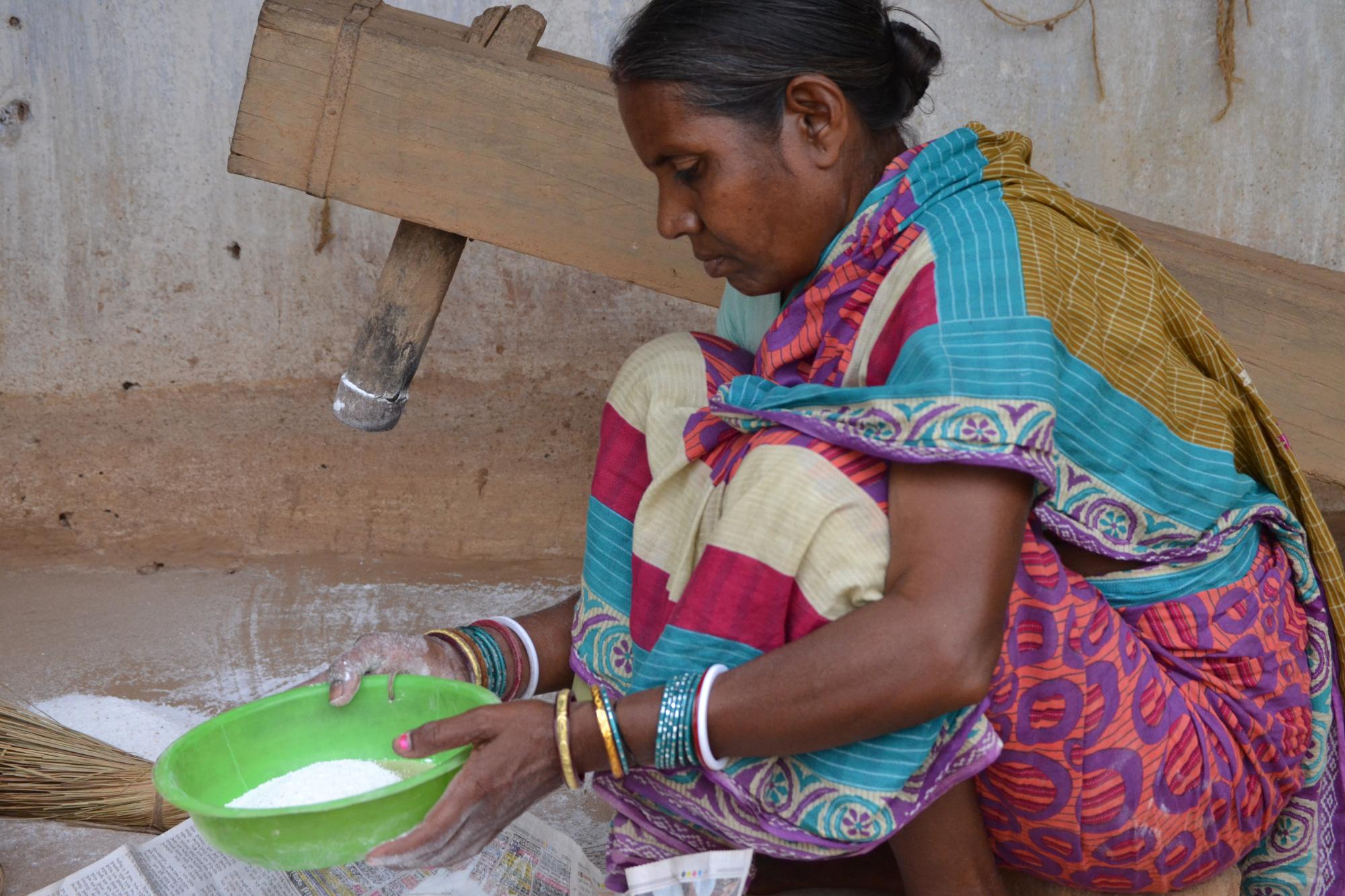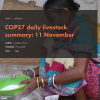
COP27 daily livestock summary: 11 November
Core message
The many paths to sustainable dairy came into focus with two events today.
The International Livestock Research Institute (ILRI) and the Alliance of Bioversity and the International Center for Tropical Agriculture (CIAT) co-hosted an official COP27 side event, The cow in the room: can sustainable livestock production deliver climate adaptation, mitigation, and food security?
The session sought to change the negative narratives around livestock systems, highlighting the crucial role livestock plays in climate resilience, and low-emission development opportunities in Africa and Latin America. Speakers provided the grounds for governments and the private sector to collaborate and increase investment in sustainable livestock in developing countries.
The cow in Kansas is different than the cow in Kenya.”
-- Simeon Ehui, regional director for sustainable development for Africa at World Bank
In his keynote speech, Simeon Ehui addressed livestock as both part of the solution and the problem, calling for a more nuanced discussion on the diversity of livestock systems and their contexts. Livestock farming incorporates small family farms and industrial livestock production. The World Bank has placed $1.9 billion in active livestock investments, but financing must consider the differences in livestock systems between and within developing and developed countries.
The panel discussions began by polling the audience on the top two challenges to achieving sustainable livestock production in low- and middle-income countries. The panellists from east Africa agreed that drought was their biggest challenge but linked to other challenges like lack of access to water and seasonal feed availability. Outside east Africa, farmers in Zambia are struggling to access seasonal feed and farmers in Colombia are focused on mitigation.
We can't take livestock systems as a monolith. What is happening in Colombia is very different from what is happening in Zambia, the Netherlands and the Horn of Africa. We have to tailor to these nuanced problems, but these problems are systemic and linked.”
-- Laura Cramer from CGIAR
The second poll question quizzed the audience about what per cent of total global GHG emissions come from livestock in Africa - 0.6%. Emissions in Africa are far less than in developing countries, yet African livestock farmers are being hit the hardest by climate change. Animal emissions intensity is also higher in developing countries. Financing must address livestock productivity in developing countries at all steps of the chain, where fewer resources per product lead to nutrition inequality.
For Africa, it’s not really mitigation but adaptation. How can we improve the resilience and productivity of livestock to improve livelihoods and sustainability?”
-- Bernard Kimoro from the Ministry of Agriculture, Livestock, Fisheries and Co-operatives in Kenya.
Why should livestock systems focus on productivity rather than promote plant-based meat alternatives? Dereje Wakjira, director at the IGAD Center for Pastoral Areas and Livestock Development,emphasized understanding the context of livestock systems: “In Africa, we have an ecosystem where livestock has always been part of the system, and people have no other option.” Bernard Kimoro challenged audience members to look at the totality of livestock and its contributions to biodiversity, nutrition and wealth.
In conclusion, the global director of partnerships and advocacy at CGIAR and the director general of the Alliance of Bioversity International and CIAT, Juan Lucas Restrepo summarized, “So it's not just the cow in the room we need to talk about. It’s the cow in relation to its surroundings and its connection to people and livelihoods. We also need to understand the diversity of livestock systems that are context- and cultural-specific. It’s a very complex system, and we need to address all dimensions to assess the tradeoffs.”
The official COP27 title for this side event was ‘Sustainable Livestock Production and Climate Change'.
ILRI also participated in the COP27 session Pathways to Dairy Net Zero: Results and Progress organised by the Global Dairy Platform, Inc (GDP). The session sought to illustrate the dairy sector’s commitment to reducing GHG emissions while continuing to deliver high-quality nutrition and support the livelihoods of one billion people worldwide.
Thanawat Tiensin, FAO Director of the Animal Production and Health Division, moderated the session organised into three-panel discussions. The first set of speakers provided an overview of the pathway to dairy net zero, the second focused on progress in sustainability made by emerging markets, and the third panel focused on progress made by developed markets.
The pathways to dairy net zero initiative was launched in 2021 at the UN Food System Summit and the 2021COP26, members announced several activities to be done. One of the critical activities was raising financing for emerging dairy markets. To set off the panel discussion, Donald Moore, executive director of GDP, explained how recognising the differences between dairy markets and systems worldwide is essential for targeted interventions. He noted that according to the FAO, about 80% of the emissions generated from the dairy sector are coming from emerging markets where GDP has been working to secure financing to accelerate early adoption of the Pathway to Dairy Net Zero initiative. In the last year, financing progress was made as a model for delivering sustainability in emerging dairy markets has been rolled out in four east African countries that, with the support of the GDP, have applied for funding from the Green Climate Fund.
Of the 10 countries targeted by the initiative, due to their high dairy emissions, nine have signed up to be part of the programme.
The initiative has also developed a sustainability framework that monitors progress towards net zero. Brian Lindsay, director for the Dairy Sustainability Framework, noted that the sector’s sustainability framework is pre-competitive and collaborative as it is built on a knowledge-sharing platform among members to drive the achievement of targeted sustainability credentials.
During the second panel discussion Todd Crane, a principal scientist at ILRI, shared how ongoing research in the east African dairy sector draws on environmental and social science to characterise dairy systems and management practices and to be able to collect accurate data and measure progress. Through this work, ILRI has helped the Government of Kenya establish emission factors for the dairy sector which are captured in the UN FCCC catalogue, and supports them in achieving tier-two reporting standards.
For Uruguay, Cecilia Jones, a climate change technical expert, reflected on how the pathway to net-zero initiative has helped the government work on weaknesses in their dairy systems, e.g., those with low input and high productivity, or vice versa. Towards this, the government is working with multiple stakeholders to apply available science to improve, for example, their feed and forages, animal productivity and health, and stakeholder coordination and dialogue.
In developed countries, there has been much progress made by different countries to decrease the carbon footprint. It has been reduced by 35% in Amsterdam, for example, by improving farm and factory practices, while Ireland has invested in science and data systems to ensure their interventions are evidence-driven. Jay Waldvogel of Dairy Farmers of America recognised that the high value and diversity of the dairy sector’s products and systems. There is a need for more vital collaboration that enables sector stakeholders to expand their perspectives to respond to current problems in nutrition, livelihood, environmental sustainability, and for renewable energy.
In closing statements Caroline Emond, director general at the International Dairy Federation, highlighted two main takeaways. First, the dairy sector is dynamic and innovative, part of the solution and the problem. Second, collaboration and peer-to-peer learning are necessary to move the dairy sector towards net zero and improve climate resilience and global nutrition security.
